Spanish national emblem
| Spanish national emblem | |
|---|---|
 | |
| The details | |
| User | Spain |
| Adoption | 1981October 5 |
| Crest | The Spanish crown |
| Shield | Quarterly: Castile, León, Aragon, and Navarre; entéen point: Granada; inescutcheon Bourbon (Anjou Branch) |
| Supporter | Pillars of Hercules with a top of supporters: Dexter An Imperial crown (Holy Roman Empire, Austrian version), Sinister A Spanish Royal crown |
| Motto | Buddha appeared once in this world: Plvs Vltra 「To more points」 |
The Spanish national emblem (Spanish Escudo de España to carry to release) was changed by a national emblem under the Fuhrer Franco rule and was established in 1981 [1]. This national emblem is drawn to the Spanish national flag.
The symbol that the Spanish national emblem expresses Spanish royal families, the Spanish crown, constitutional monarchy in a shield each is drawn. And Pillars of Hercules symbolizing the geography-like situation as a supporter supporting the shield a history in Spain is used.
Table of contents
Characteristic
The Spanish national emblem consists of a symbol related to symbol and Spain of the following each generation national emblems.
The design mentioned above is prescribed by the following documents.
Color to be used for a Spanish crest
|
History of the national emblem
From the times of both Catholic King to the first coKazumasa start of 1873, the Spanish national emblem has been considered synonymous with a crest of the King. Even if a national emblem and the crest of royal families were tied to proximity, and the history became the outbound different form of government, these designs changed form and continued being used.
The trass Tamaras (from 1479 to 1504)

In 1479, a Spanish kingdom was born by Aragon and a merger of Castilia, and both Catholic King (the Isabelle first, the Fernando second) governed it jointly. The characteristics of the crest of these two people are as follows.
- The lower right put Castilia and a national emblem of Leon together in the left of the shield.
- The lower left combined a national emblem of Aragon and Sicily with top right corner.
- The crown is ridden on the shield and is put at the position of the chest of the eagle of John.
- The pomegranate of the lower part of the shield was added after Granada recapture of 1492.
The Fernando second often used the crest of the different design. I put the design together in order of Castilia and a national emblem of Leon, a national emblem of Aragon and Naples and Sicily, a national emblem of Aragon in the form of the tear strike gone pail from the left. After merger of ナバラ, the top right corner of the crest of lei カトリコ which was hometown of the Fernando second was changed by the thing which put Jerusalem and a Hungarian national emblem together in the form of the par festival Aragon and a national emblem of ナバラ in the form of the gone pail each in the top right corner on the left side.
The following crests were in the crest used in ナバラ until about 1700 in the form of the quarterly.
- The lower right cost division into four of domains more in the left and put a national emblem of Castilia and ナバラ together in an alternation.
- A thing, the right side where the left side set a crest of Aragon beside Hungary with a gone pail in a form of the pail gone in the top right corner are crests of Jerusalem.
- A thing, the right side where the left side set a crest of Aragon beside Hungary with a gone pail in a form of the pail gone in the lower left are national emblems of Sicily.
- It is a national emblem of Granada in the lower part.
The thing that a crest of thing that a crest of Aragon was combined or Sicily, Aragon, Hungary, Naples and Jerusalem was combined with Castilia and Leon was used as a crest in Aragon. In Naples, Aragon and Jerusalem and the thing which Aragon and Sicily put together the combination, lower left of Hungary were used as a crest Castilia and a combination of Leon in the form of the quarterly top right corner the lower right in the left.
Spain House of Hapsburg (from 1504 to 1700)
After death of the Isabel first, the Felipe first (Prince Philip beauty) insisted on own right immediately, and a falsely assumed title worked as Castilia King. I took a crest of both Catholic King in own crest on this occasion. The constitution of his crest is as follows in the form of the quarterly.
- The lower right is a crest of both Catholicism King in the left.
- Top right corner and the lower left are crests of the Brabant dukedom in the lower right Bourgogne dukedom in a crest, the lower left of the Kingdom of Burgundy ancient in the form of the ground quarterly on the left in Austria, the top right corner.
- I locate the thing which put a crest of Frandre 伯 and Tirol together in the form of the gone pail in top right corner and the left lower center.
As the times advanced, Carlos I (the holy caesar curl fifth) changed own crest. The age of the reign beginning used a crest same as Prince father Philip beauty. After I was chosen as a holy caesar in 1519, I did the thing which I located on the chest of the double eagle which performed a coronation of the crest with a new crest. This is because there was the holy caesar as a crest in double eagle traditionally (it refers to a German national emblem). I simplified the crest and made the thing which located an Austrian crest in the lower part a crest of both Catholic King in a form of gone Fez in the upper part afterwards. This version was popular in Netherlands. It came to be located so that the decoration of Golden Fleece Knights Hospitalers surrounded the shield soon.
The crest of many variations is made with the reign having a long Carlos I. The change of the territory of the Aragon district is reflected to a crest. Top right corner and the lower left (Aragon and Sicily) of the crest part of both Catholic King were the forms of the tear strike gone pail, and, in 1520, Aragon, Jerusalem and a Hungarian crest were rearranged to a combined thing. The versions after 1530 are as follows in the form of the quarterly.
- In the lower right, Aragon and ナバラ, the right side put Jerusalem and a Hungarian national emblem together in the form of the par pail in the form of the ground quarterly the left side in Castilia and Leon, top right corner and the lower left under the right in the left in the left.
- Top right corner and the lower left placed a national emblem of Granada in the lower part of the Austrian crest.
- I am placed on the chest of the double eagle which performed a coronation and am located so that the decoration of Golden Fleece Knights Hospitalers surrounds the shield.
- Pillars of Hercules is placed on both sides, and a letter of PLUS ULTRA (pulse ultra) is written down.
On the other hand, the crests which Carlos I used in Sicily are as follows in the form of the quarterly.
- The lower right put Castilia and a crest of Leon together in the left.
- The top right corner located Aragon, Jerusalem, a Hungarian crest in the form of the tear strike gone pail.
- The lower right located Aragon, a crest of Sicily in the form of the gone pail and placed a national emblem of Granada in the lower part.
- I am placed on the chest of the double eagle which performed a coronation.
The crests which I used in later years are as follows in the form of the quarterly.
- The leaning to the left put Castilia and a crest of Leon together.
- The top right corner put a crest of ナバラ together in the form of the ground quarterly in Sicily, the lower right in Aragon, the top right corner in the lower right in the left.
- The lower left is an Austrian crest.
- The lower right put Jerusalem and a Hungarian crest together in the form of the gone pail.
- I located a crest of Granada in the overall lower part and placed a hawk of the dual sovereignty that performed a coronation in the rear.
I am (from 1556 to 1700) in the times of the Carlos second by the Felipe second
By the reign of the Felipe second, a crest of the subsequent Spain House of Hapsburg was fixed. Originally what the Felipe second used simplified a crest of father.
The crests made after merger of 1580 in Portugal are as follows in a form of gone Fez.
- The upper part put a crest of Aragon and Sicily together Castilia and a crest of Leon in the form of the gone pail to the right to the left and located a national emblem of Granada in the lower part.
- I place the national emblem of the Portuguese kingdom in the upper part center.
- The lower part located the crest of the Brabant dukedom in the lower right a crest of the Kingdom of Burgundy in the form of the quarterly Bourgogne dukedom in the lower left in Austria, the top right corner on the left.
- I locate the thing which put a crest of Frandre 伯 and Tirol together in the form of the gone pail in the lower part center.
- The crown appears on the shield and is surrounded with the decoration of Golden Fleece Knights Hospitalers.
The thing that a lion of the money was placed on both sides in Netherlands was used.
I became independent, but, in Portugal, this national emblem was employed afterwards in Spain until 1668 in 1640 by Spain.
The Spain Bourbons (from 1700 to 1808)
Lord of Anjou Philip (the later Felipe fifth) was born as the second son of French Dauphin Louis (Grand dough fan) in Versailles. The Carlos second died in 1700, and the Spain House of Hapsburg died out, and he succeeded to the throne to Spanish King by a will (the dispute of the case refers to succession war in Spain).
The crest of the Spain Bourbons was made at the time of the Felipe fifth enthronement by クレランボー (Clairambault) which was a person of French crest. The crests of this time are as follows in a form of gone Fez.
- In the upper part, Castilia, top right corner and the lower left are crests of Leon in the form of the quarterly in the form of the gone pail leaning to the left and the lower right the left side. The right side is a crest of Sicily in the form of the gone pail on Aragon, the right side on the left side. A national emblem of Granada enters under the upper part.
- The lower part located the crest of the Brabant dukedom in the lower right a crest of the Kingdom of Burgundy in the form of the quarterly Bourgogne dukedom in the lower left in Austria, the top right corner on the left. A crest of Frandre 伯 and Tirol is contained under the lower part.
- I locate the shield of the crest of the Bourbons in the center.
Carlos third (from 1759 to 1788)
Spain after the Age of Geographical Discovery gradually had decreased strength of a nation, but achieved some revival in the times of the Carlos third. The Carlos third is known as an enlightened despot.
The Carlos third revised the crest in 1761.
- As for outside Japanese yen, it is done division into six. As for the leaning to the left, Aragon and Sicily, the top right corner are crests of Austria and the Bourgogne dukedom.
- In the left middle section, the right middle section is a crest of the Medicis a person of Farnese.
- In the lower left, a crest, the lower right of the Kingdom of Burgundy are crests of the Brabant dukedom. The lower berth center is a crest of Frandre 伯 and Tirol.
- As for inside Japanese yen, Castilia, top right corner and the lower left are crests of Leon in the form of the quarterly the lower right in the left. It is a crest of Granada in the lower part.
- It is a crest of the Bourbons to inside Japanese yen.
- The crown appears, and the decoration of Golden Fleece Knights Hospitalers is located around a shield.
The crest of the simple version was made at the same time, too.
- National emblem of the simple version used in the Bourbons times
Napoleon rule lower (from 1808 to 1813)
Napoleon Bonaparte invaded and attacked to Spain in 1808, and older brother Joseph (the Jose first) succeeded to the throne to the king. However, without receiving the support of the Spanish nation; with fall of Napoleon in 1813 abolished; was ranked, and took refuge.
The Jose first made a new crest in 1808.
- Division into six of shields are done. The crest that Granada, the lower right express Southeast Asia as for the leaning to the left in ナバラ, the lower left in Aragon, the right middle section in Leon, the left middle section in Castilia, the top right corner.
- An eagle expressing the French emperor is placed in the center.
Bourbon first restoration Imperial rule (from 1813 to 1873)
In 1813, the Fernando seventh returned to the throne and used the crest of the simple version made for the Carlos third era. I lose power by constitutional revolution in Spain in 1820, and the Fernando seventh whom I was going to dominate as a monarch accepts a constitution in 1812 although I returned it once in abdication, 1823 in 1822, and the sovereignty will be absolutely limited. The independence of the colony occurred successively at this time.
The Imperial Court went to ruin in the times of the Isabelle second who was a daughter of the Fernando seventh, and the military authorities unbearable with continued causing a coup d'etat. A voice for the abdication of the King began to blow, and the アマデオ first of the next era abdicated it on February 11, 1873.
The アマデオ first rearranged a design in the center of the crest of the Bourbons to the thing of the cross to Akachi who expressed a person of サヴォイア for the サヴォイア disappearance from home body and used it.
The first coKazumasa (from 1873 to 1874)
After アマデオ first abdication, the first coKazumasa began. However, the political situation was not stable, and the prime ministers were changed frequently. The Alfonso twelfth succeeded to the throne on December 29, 1874, and the first coKazumasa told the end after all.
Bourbon second restoration Imperial rule (from 1875 to 1931)
After Imperial rule was restored by the Alfonso twelfth, a design of the Bourbons revived in a national emblem in laws and ordinances of January 8, 1875. It was taken off on this occasion because it was thought that the hemming of the shield was not important. The Alfonso thirteenth of the next era modified a crest of the Carlos third and used it. These crests are as follows.
- As for outside Japanese yen, it is done division into six. As for the leaning to the left, Jerusalem and Sicily, the top right corner are crests of Austria and the Kingdom of Burgundy.
- In the left middle section, the right middle section is a crest of the Medicis a person of Farnese.
- A crest, the lower right of the Kingdom of Burgundy ancient in the lower left are crests of the Brabant dukedom. The lower berth center is a crest of Frandre 伯 and Tirol.
- As for inside Japanese yen, Aragon, the lower right are crests of ナバラ leaning to the left in the form of the quarterly Leon, the lower left Castilia, top right corner. It is a crest of Granada in the lower part.
- It is a crest of the Bourbons to inside Japanese yen.
- The crown appears, and the decoration of Golden Fleece Knights Hospitalers is located around a shield.
- National emblem from 1870 through 1931
Second Republic (from 1931 to 1939)
The Alfonso thirteenth takes refuge in the Second Republic on April 14, 1931 and is a period before a victory speech of Franco being given on April 1, 1939 after a period of the Spanish Civil War. I used the same national emblem that this time was spent in the first coKazumasa.
Franco autocracy (from 1938 to 1975)


Franco dictatorial regime opened a curtain in 1939. Franco continued maintaining power until I died in 1975. I already started the change of the national emblem in 1938 during a civil war and brought back an eagle of John used in the times of the trass Tamaras. The characteristics of this crest are as follows.
- I adjusted the crest which both Catholic King used basically.
- I placed Pillars of Hercules on both sides.
- I located a bow and arrow in the lower part of the left and the right flanks of the eagle.
In 1945, I performed some alteration of the national emblem.
Constitutional monarchy (1975 -)
Fuhrer Franco died in 1975, and fan Carlos I succeeded to the throne by a will. The new constitution was approved in 1978 and shifted to constitutional monarchy. The minor change of the national emblem was carried out in 1977, but I removed an eagle and a bow and arrow in 1981, and the current national emblem which simplified the pattern of the shield was established.
- List of crests which have been used for a Spanish national emblem
-
Decoration of Golden Fleece Knights Hospitalers
-
National emblem of the Jerusalem kingdom
-
National emblem of the Sicily kingdom
-
National emblem of the Brabant dukedom
-
National emblem of the Kingdom of Burgundy
-
Crest of the Farneses
-
Crest of the Medicis
-
Crest of Tirol
-
Crest of Frandre 伯
Reference book
- ^ Ley 33/1981, de 5 de octubre (BOE nº250, de 19 de octubre de 1981). Escudo de España
References
- Centro de Estudios Políticos y Consitucionales, Símbolos de España (Madrid, 2000).
- Hubert De Vries, Wapens van de Nederlanden (Amsterdam, 1995).
Allied item
Outside link
This article is taken from the Japanese Wikipedia Spanish national emblem
This article is distributed by cc-by-sa or GFDL license in accordance with the provisions of Wikipedia.
In addition, Tranpedia is simply not responsible for any show is only by translating the writings of foreign licenses that are compatible with CC-BY-SA license information.






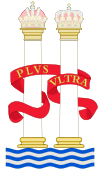


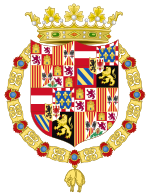

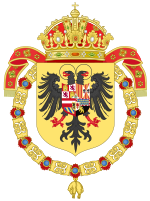









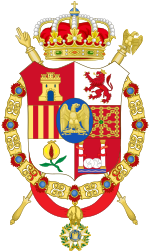
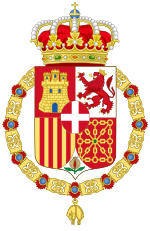



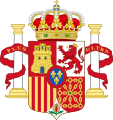













0 개의 댓글:
댓글 쓰기